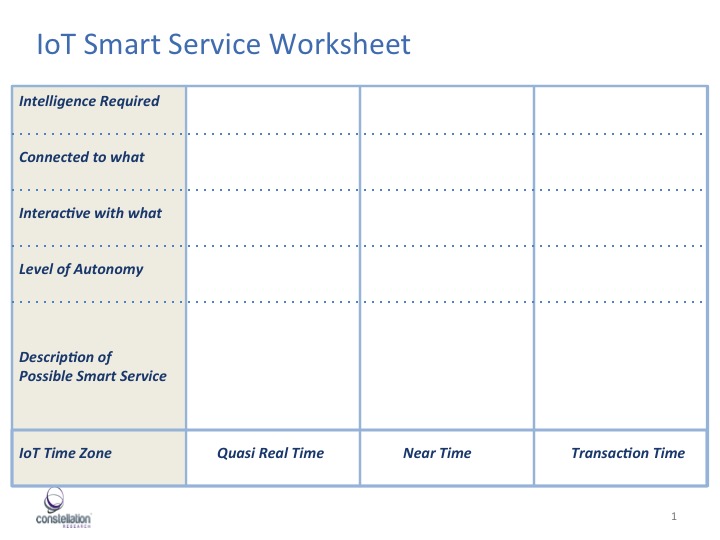The first stage in any technology build and deploy project is to capture a well-structured business requirement to work from. The more innovative, and the higher the business value, the more difficult this becomes. Finding common ground between business and technology in respect of IoT based Smart Services deployments is particularly challenging.
When business values and technology capabilities are new and truly innovative market-disrupting moves are being sought then finding a method to focus ideas, capture and translate into technology requirements is difficult.
Many enterprises have been searching for methods to develop innovative ideas as the pressure for new revenues from Digital and Services products intensifies. Anyone who has taken part in such exercises will testify placing people in a room with the instruction to look for innovation does not guaranteed a World beating outcome. The normal result will be some good outcomes that increase the competitiveness, or effectiveness of current positioning.
A previous post on IoT deployments suggested obtaining focus by concentrating in turn on possibilities to Improve, Innovate, Partner or Disrupt. This blog post is concerned with creating and capturing prospective innovative business ideas for Improve and Innovate. The planned follow on blog post will examine how to achieve the more complex market impacts that Partner or Disrupt can provide.
Improve is always an easier option as the possible challenges to address are usually recognizable. In many cases IoT is needed to do little more than provide increased data on previously untracked aspects. New ideas to improve an existing capability should mean that an experienced business team will quickly be able to identify options to pursue. In this case the challenge will be to capture the options for a technology feasibility study.
To Innovate is always tough as, by definition, it means radically different activities from existing actions, therefore usually outside the direct experience of participants. In a workshop this challenges the basic knowledge and experience available to come up with innovative business valuable offerings. The degree to which this can challenge the accepted wisdom was the topic in the blog on Smart Cities and local government management.
The use of tools, or methods, that create, or drive the refinement, of Innovative ideas is an important aide. The recent blog post entitled executive summary of IoT functionality introduced some important elements that are common to IoT solutions, and can act as a focusing mechanism for developing ideas. The concept of three time frames, and four attributes, is a key principle in defining an IoT Smart Services Solution, but can equally be used to assist innovation creation and business requirement capture. This blog will not repeat the details of the Three by Four reference model again, but will add an example of mapping Uber to the model.
A three x four model provides up to 12 functionality points of definition for an IoT Smart Service. Said this way it seems to increase complications, but laid out in the table below as a worksheet it makes the point simply.

This worksheet can be used in two different ways; firstly to capture an idea for an IoT Smart Service, and then break down the idea into distinct requirements; Alternatively to populate boxes with recognizable existing enterprise, or market place capabilities, with the goal of stimulating ideas by reference to existing capabilities.
Innovative thinking is always difficult to ‘spark’ so a focusing method is important. Resulting Smart Services are usually easy to define in terms of the Business Proposition and value delivered, but notoriously difficult to define in terms of what Business Assets are required to make the idea possible.
The Constellation Research Report Implementing a Business Workshop on the Internet of Things how to develop and execute IoT focused workshops for researching market competition, defining enterprise resources, and to create strategic milestones for building a market disruption. The following is two snap shots examples rather than full explanations.
Without the rest of the report giving the broader context and explanation as well as significant material to build up the level of understanding this may be difficult to follow. The intent is merely to illustrate that there are methods to focus thinking and develop truly innovative Smart Services using the full capabilities of IoT.
IoT based Smart Services use an entirely new set of technology capabilities that the World Economic Forum annual Davos meeting will debate, together with other issues, under the heading of the ‘The Fourth Industrial Age’.
Finding ways for your Enterprise to understand and re compete against new competitors in new markets makes developing tools and methods for an essential target for 2016.
Two Outline Examples
Outline example 1; Requirement to Improve;
Adding factory floor progress data to provide faster updates to an Enterprise Production Planning Application. Method; Populate the four headings in Transaction Time with the details of the Enterprise Production Planning Application and now consider if this requires quasi real time, or near time updating as an IoT requirement, before deciding exactly what is required under each of the four headings to provide the required inputs.
Outline example 2; Requirement to Innovate
By creating a new Smart Service. Method; Decide if the Smart Service is Quasi Real Time, or Near Time, then populate the four boxes with the necessary business functionalities required. It might sound complicated so perhaps using Uber Taxi Smart Service to illustrate might be helpful. Note there is no requirement for Quasi Real Time in this Smart Service Example



